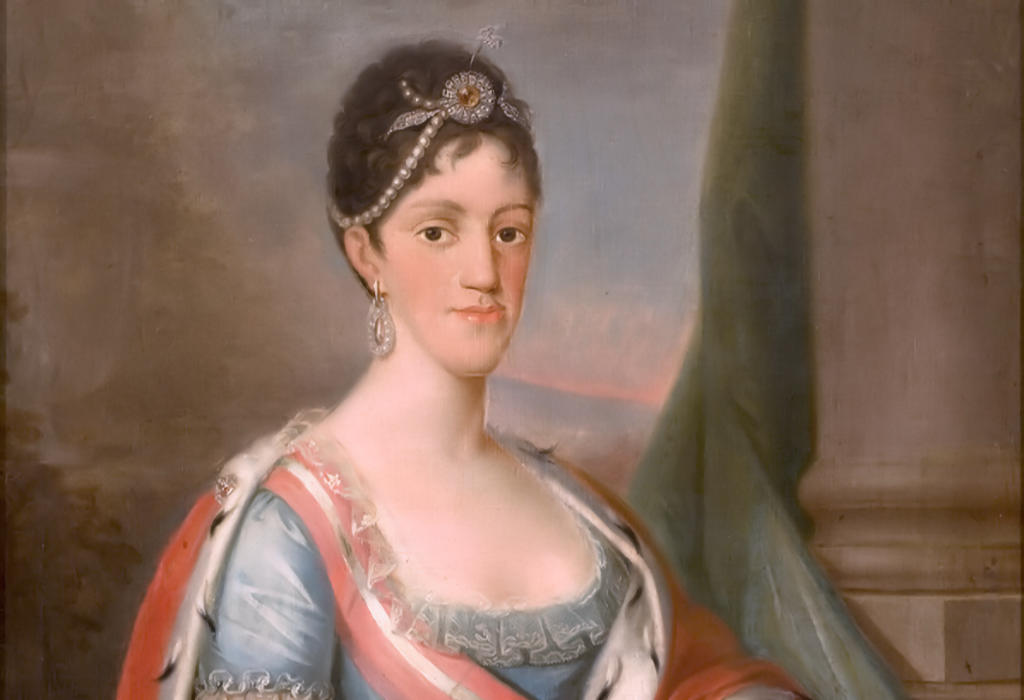In 1817, her son Pedro married the Archduchess Leopoldina of Austria, and the royal family returned to Portugal in 1821. However, Carlota Joaquina's position had changed significantly. She was confined to the Royal Palace of Queluz, where she lived a lonely and abandoned life. On January 7, 1830, she passed away, left to her own devices without the support or presence of her children.
Carlota Joaquina's early years were spent in the Royal Palace of Aranjuez, where she was born. As the second child of Charles, Prince of Asturias, and Maria Luisa of Parma, she received the full name of Carlota Joaquina Teresa Cayetana. However, she was commonly referred to as Carlota. Her name honored both her father and her paternal grandfather, King Charles III of Spain, who adored her as his favorite granddaughter. Despite the strictness of her education and the court's etiquette, Carlota Joaquina was described as mischievous and playful.
Raised in a deeply Catholic environment, Carlota Joaquina received an education that focused on religion, geography, painting, and horseback riding, which she particularly enjoyed. The Spanish monarchy imposed rigid norms of behavior and etiquette on the royal family and the court. While King Charles III was reserved and dedicated more time to his family than to the court's social activities, Carlota's mother, Maria Luisa, actively participated in court entertainments, organizing luxurious parties where moral standards were often disregarded. Unfortunately, these behaviors contributed to a negative public perception of Maria Luisa, who was seen as promiscuous and unfaithful to her husband, even after giving birth to a long-awaited male heir in 1784. The unpopular reputation of her mother deeply affected Carlota Joaquina and her siblings.
The arrangement of Carlota Joaquina's marriage was orchestrated by her father, King Charles III, and her paternal aunt, Mariana Victoria, the Dowager Queen of Portugal. Mariana visited Spain in the late 1770s to foster diplomatic relations between the two countries. It was decided that Carlota Joaquina would marry Infante John, Duke of Beja, the youngest grandson of Mariana Victoria, while her paternal uncle, Infante Gabriel of Spain, would marry Infanta Mariana Vitória of Portugal, the surviving granddaughter and namesake of the Dowager Queen.
Before the marriage could take place, Carlota Joaquina's abilities were put to the test. She underwent a series of public examinations in front of the Spanish court and Portuguese ambassadors, who evaluated her qualities as a potential bride for the second son of Queen Maria I of Portugal. The exams were highly successful, and the marriage proceeded. On May 8, 1785, the proxy marriage ceremony was held, and three days later, on May 11, Carlota Joaquina, accompanied by her entourage, left Spain for Lisbon. As she departed, Carlota Joaquina requested a painting of herself in a red dress to replace a portrait of Infanta Margaret Theresa of Spain, believing herself to be more beautiful. The official wedding ceremony between Carlota Joaquina and Infante John of Portugal took place on June 9, 1785. At the time, Carlota Joaquina was only 10 years old, while her husband was 18. Due to her young age, the consummation of the marriage was delayed until January 9, 1790, when she was finally able to conceive and bear children.
Lisbon.vip Recommends
Her more liberal habits and customs often clashed with the societal norms expected of women in Portugal. Portuguese men disapproved of her public behavior, political involvement, and her departure from the traditional roles assigned to women. As most Portuguese women were deprived of social freedoms, Carlota Joaquina's actions fueled malicious rumors within the court. The Duchess of Abrantès, wife of the French General Junot, who later invaded Portugal, ridiculed Carlota Joaquina for her behavior and appearance, describing her as extremely ugly.
Carlota Joaquina's life as the Queen of Portugal was marked by controversies, political intrigue, and strained relationships. Despite her reputation and the challenges she faced, she remains a significant figure in history, a woman whose actions and influence left a lasting impact on the courts of Portugal and Brazil.



